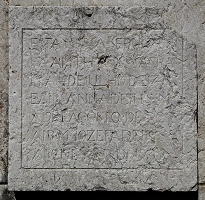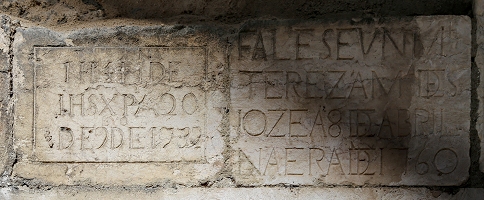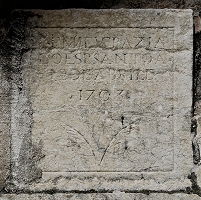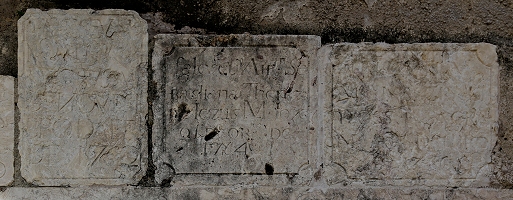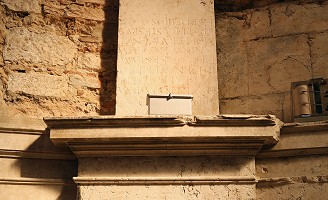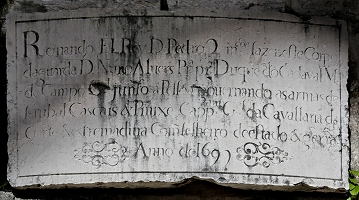
Home | Church list | Blog posts | Why PoorFrankRaw? | Contact | Shop
Lettering in Lisbon: The Carmo
See Part II of my notes on the Carmo.
At 9.40AM on 1 November 1755 an earthquake struck off the coast of Lisbon. Much of the city was destroyed in the quake and subsequent tsunami and fires, and estimates put the number of deaths between 30,000 and 50,000. As much as 85% of the city was destroyed.
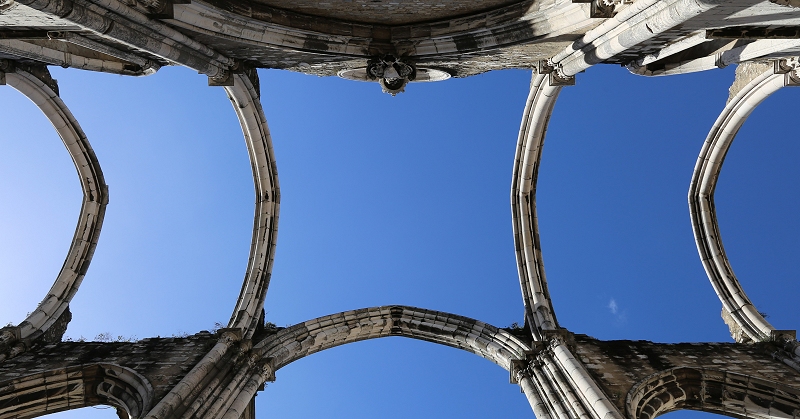
The Convent of Our Lady of Mount Carmel, now known as the Carmo, was badly damaged and the entire library of 5000 books was lost. The sacristy survived and is now used as a museum. The roofless nave of the church is open to visitors and holds many monuments and pieces of carved lettering from several centuries. Some of the items described below are in the open nave of the church, others are in the museum.
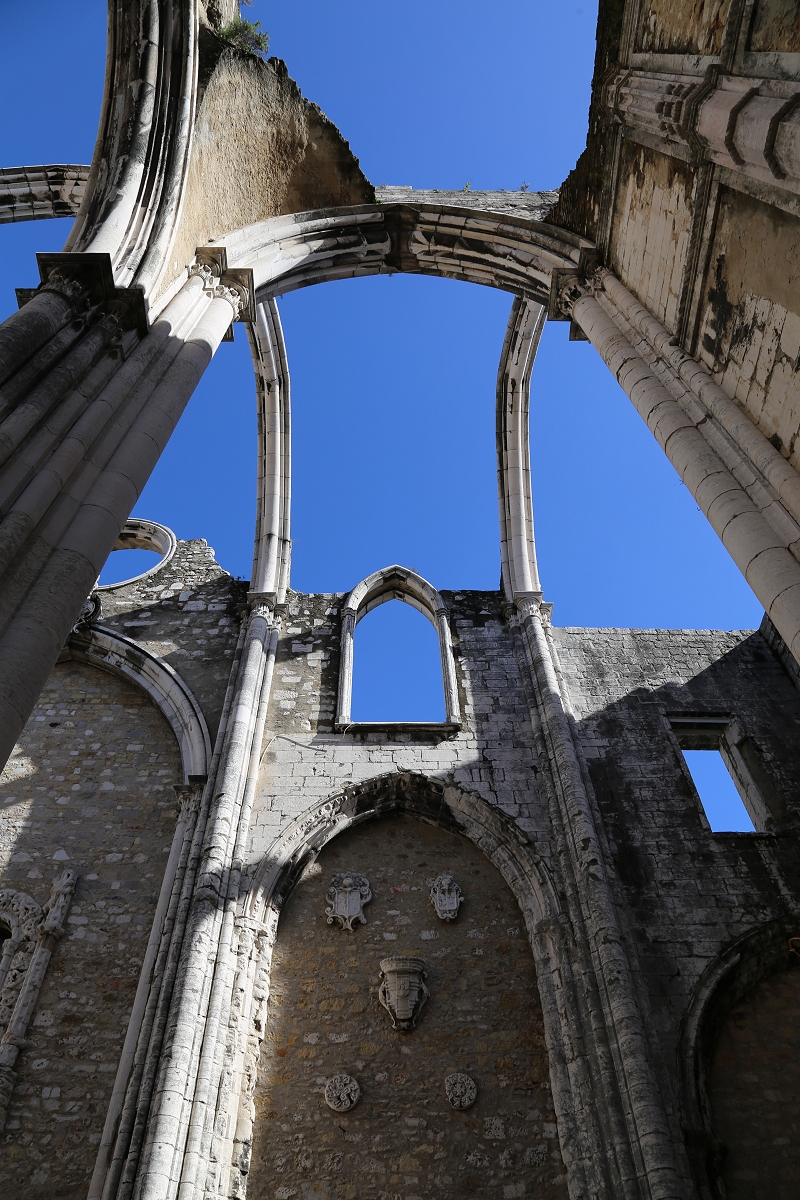 Founded in 1389, construction of the new convent and church were started around 1393. The first services were held in 1407. Over the centuries a number of earthquakes caused damage to buildings in the city of Lisbon, including the Carmo, but the great quake of 1755 ended its use as a convent. The buildings had a variety of secular uses in the 18th and 19th centuries until the remains of the church were stabilised and partially repaired. Some of the slender arches which today look so fine against the blue sky were rebuilt in 1911/12.
Founded in 1389, construction of the new convent and church were started around 1393. The first services were held in 1407. Over the centuries a number of earthquakes caused damage to buildings in the city of Lisbon, including the Carmo, but the great quake of 1755 ended its use as a convent. The buildings had a variety of secular uses in the 18th and 19th centuries until the remains of the church were stabilised and partially repaired. Some of the slender arches which today look so fine against the blue sky were rebuilt in 1911/12.
Portugese ligatures
Ligatures appear widely in manuscripts and carved lettering. A ligature is just a merging or combining of two or more letters. Ligatures sometimes evolve over time (&), or are used for reasons of spacing - a merged LA helps reduce the open space between the upright of the L and left stroke of the A - or just as a stylistic device like some of those I commonly use when carving letters.
The Roman lettering in the Carmo features liberal use of ligatures, both the common and the uncommon. The common pairings below can be seen widely in Roman lettering, and here I include LI, LL and LO as ligatures, though they can be argued to be more a matter of style as the letters do not really merge:

The lettering in Lisbon opened my eyes to many more ligatures, some of which I have seen nowhere else. Here, redrawn, are the ones I spotted:

Doubtless with more time, more photographs and a slower walk through Lisbon I could find more. Add to these the common Latin (and Portugese) contractions such as a bar over a vowel to indicate the insertion of M or N, plus occasional Tironian notes and other signs and symbols, and reading the inscriptions becomes quite a challenge. You should be able to find several of the above in the following images from the city.
Pope Clement VII
Construction of the Carmo was completed around 1407. Several popes later, Pope Clement VII was elected (not to be confused with an earlier Clement VII and indeed an earlier Clement VIII). This Clement gave an order which offers 40 days remission of sins for faithful Christians who either kiss a cross at, or visit, the convent.
There are three inscriptions at the gate which refer to this order. Two with the same inscription - one in blackletter and one, probably added later, in Roman lettering. A third stone gives a slightly different version of the same proclamation.
The first, in blackletter and carved into the wall stone, bears a date of 1523. Judging by the style of Arabic numerals in the date it looks like it was carved at about that date:
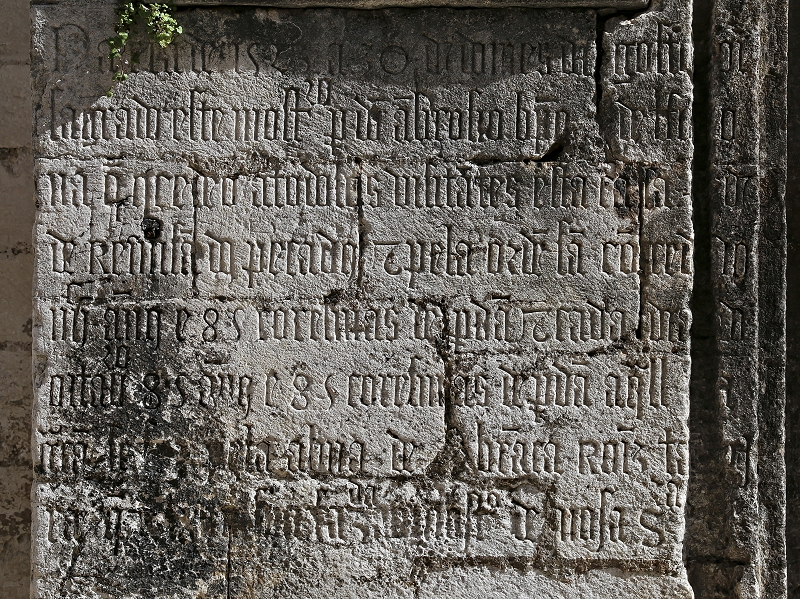
Directly below it is a stone panel set into the wall with the same inscription, but in (easier to read) Roman letters. Again using the style of the Arabic numerals of the date, this was added maybe a century later - perhaps the faithful were already finding the blackletter version hard to read:
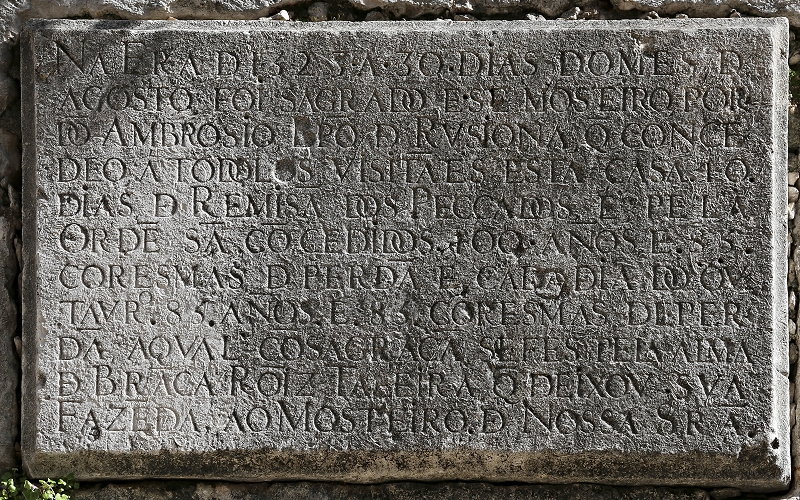
The inscription reads:
NA ERA DE 1523 AOS 30 DIAS DO MEZ DE AGOSTO FOI SAGRADO ESTE MOSTEIRO PR D. AMBRÓSIO, BISPO DE ROSSIONA, QUE CONCEDEO A TODOS OS VISITANTES DESTA CAZA, QUARENTA DIAS DE REMISSÃO DOS PECCADOS, E PELA ORDEM SÃO CONCEDIDOS QUATROCENTOS ANNOS, E OITENTA E CINCO QUARENTENAS DE PERDÃO, A QUAL SAGRAÇÃO SE FEZ PELLA ALMA DE BRANCA RODRIGUES TALHEIRA, QUE DEIXOU SUA FAZENDA AO MOSTEIRO DE NOSSA SENHORA
Using an online translator and given the usual caveats of my lack of Portugese and the imperfect nature of automatic translations, this comes out as:
IN THE YEAR 1523 ON THE 30TH DAY OF AUGUST THIS MONASTERY WAS CONSECRATED BY AMBROSIO, BISHOP OF ROSSIONA, WHO GRANTED ALL VISITORS TO THIS HOUSE FORTY DAYS OF REMISSION OF SINS, AND BY ORDER FOUR HUNDRED YEARS AND EIGHTY-FIVE QUARANTINES OF PARDON ARE GRANTED, WHICH CONSECRATION WAS DONE BY THE SOUL OF BRANCA RODRIGUES TALHEIRA, WHO LEFT HER ESTATE TO THE MONASTERY OF OUR LADY
Another inset panel has a different reference to the remission of sins:
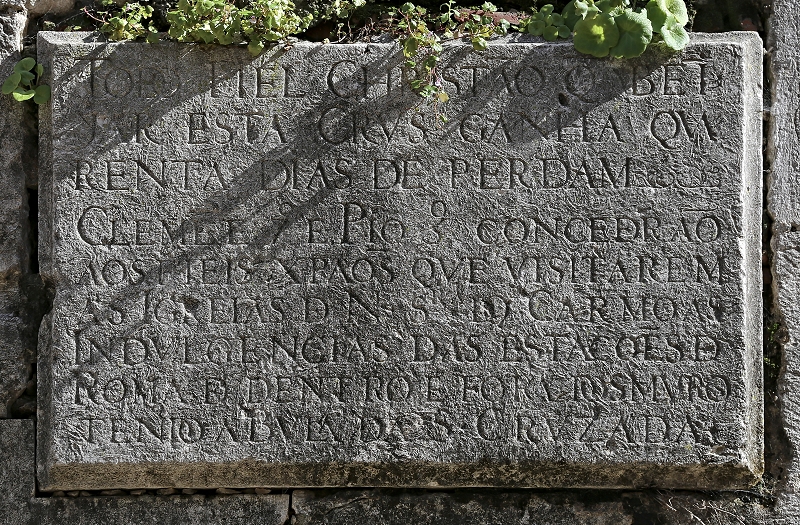
This panel is of a similar stye and date to the panel above, and again through an online translator reads:
EVERY FAITHFUL CHRISTIAN WHO KISSES THIS CROSS GAINS FORTY DAYS OF PARDON CLEMENT VII AND PIUS V WILL GRANT TO THE CHRISTIAN FAITHFUL WHO VISIT THE CHURCHES OF OUR LADY OF MOUNT CARMEL THE INDULGENCES OF THE STATIONS OF ROME INSIDE AND OUTSIDE THE WALLS HAVING THE BULL OF THE HOLY CRUSADE
An indulgence, in Catholic theology, is "a way to reduce the amount of punishment one has to undergo for sins". By the time Clement VII decreed that by kissing the cross at / visiting the Carmo would benefit the faithful, the practice of the uncontrolled sale of indulgences was already widespread and had become a problem for the Catholic church. This offer relating to the Carmo seems less controversial than some of the more notorious abuses intended solely to raise funds.
Tomb Markers
The Carmo has a variety of memorials on the walls which may have once been horizontal, used as ledgers over a tomb below, or may have always been vertical. Some have unsurprisingly been moved and one has been reused upside down to face a pillar in what is now part of the museum.
Some of these memorials have a heraldic device with some text, others have just an inscription. Most of this first group are small memorials from the 17th and 18th centuries, made to a size, a budget and a standard of work in keeping with the middling rank of the person memorialised (click any of these thumbnails to see a larger version):
The last of these, with a curved front face, seems to record some of the titles of Nuno Alvares Pereira, 1st Duke of Cadaval. The stone is dated 1699 but that is not the date of his (birth or) death and I am yet to find the purpose of this durable announcement of several of his titles - the "Captain General of the Court and province of Extremadura" among others.
The passage of time
When we look at an old monument, all of the details - who, where and when - are in the past. The stone used for the monument may have eroded over time, or may have been broken, or moved. Sometimes the details recorded on a monument, or the expectations stated, are changed as time passes by.
This monument at the Carmo, found in the chapel of São Luís Gonzaga, shows the passage of time quite well:
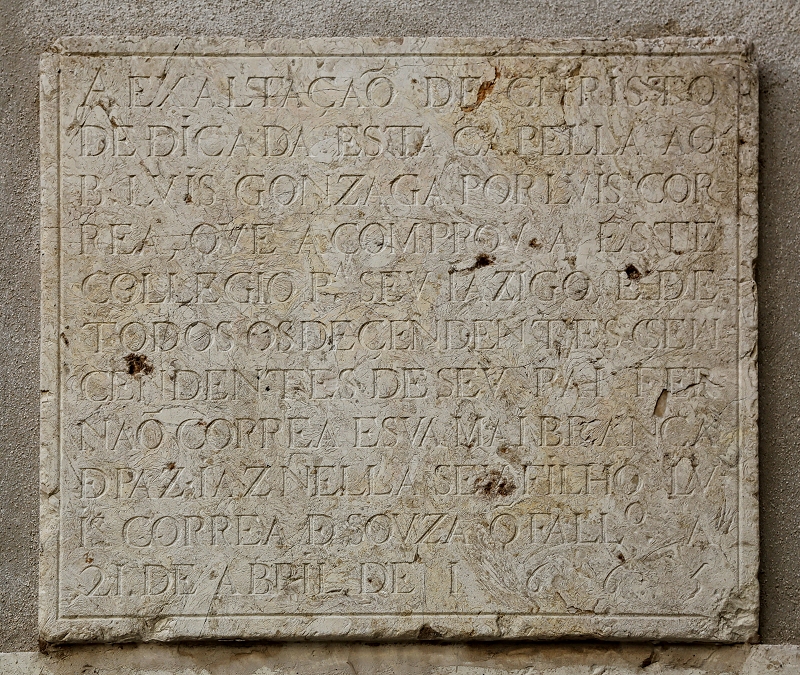
The surface of the shelly limestone has eroded somewhat, so fissures have opened where the shells and fossils in the stone meet the limestone matrix. This can mean straight lines appear in places which look like additional strokes to letters. Given the tendency of Portugese letter carvers to use unusual ligatures, this can lead us astray when reading the text. However, with a bit of study, we see that this text reads:
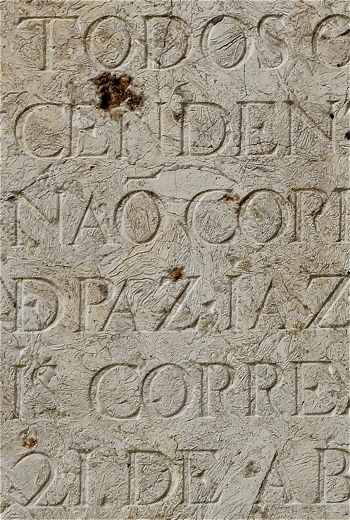 Á EXALTAÇÃO DE CHRISTO
Á EXALTAÇÃO DE CHRISTO
DEDICADA ESTA CAPELA AO
B. LUIS GONZAGA POR LUIS CORREA
QUE A COMPROU A ESTE
COLLEGIO PARA SEU JAZIGO E
DE TODOS OS DESCENDENTES E OS
ASCENDENTES DE SEU PAI
FERNÃNDO CORREIA E SUA MAI BRANCA
DA PAZ E IAZ NELLA SEU FILHO
LUIS CORREIA DE SOUSA QUE FALECEU A
21 DE ABRIL DE 1665
Which as far as I can make out translates as:
TO THE EXALTATION OF CHRIST
THIS CHAPEL IS DEDICATED TO
B. LUIS GONZAGA BY LUIS CORREA
WHO PURCHASED IT FROM THIS
COLLEGE FOR HIS TOMB AND
ALL DESCENDANTS AND
ASCENDENTS OF HIS FATHER
FERNANDO CORREA AND HIS WHITE MAIDEN
OF PEACE IAZ NELLA, HIS SON
LUIS CORREA DE SOUZA WHIO DIED ON
21 APRIL 1665
The B in front of the name Luis Gonzaga refers to the (then) Beatified Aloysius Gonzalez. Sixty years after his death he was already sufficiently venerated to have a chapel dedicated to his memory, and he was canonised in 1726.
The chapel was bought (or paid for) by Correa in June 1666 so perhaps his son was buried elswhere and reinterred at the chapel later, or already buried in the chapel and the purchase and memorial came later.
My lack of Portugese means I am unsure of the meaning of "WHITE MAIDEN OF PEACE IAZ NELLA", I am guessing that this is an honorific with the name of his mother Iaz Nella - I am happy to be corrected on this.
This type of stone is used widely around the Carmo, often with letters infilled with black paste or mortar, which would add useful contrast on memorials in a dark chapel. Here though there is just a tiny amount of filler left, in the second O of TODOS, and possibly on the N on the next line. The letters are cut quite shallowly, which may have helped the paste come loose. Also, the memorial has been through a massive earthquake and probably a couple of relocations, so we shouldn't be surprised if the filler has come away.
The layout and carving of the memorial are well executed and with the black infill intact would have made an impressive and dignified memorial to the members of the family named and those yet to come.
See Part II of my notes on the Carmo.
